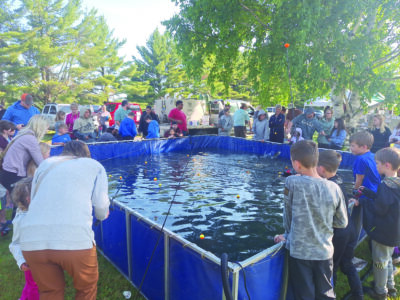The Copper Country’s first common carrier
The Calumet and Hecla mining companies surprised the industry with the richness of both the conglomerate lode, mined by the Calumet, and the Hecla’s amygdaloid lode. When the two companies merged in 1871, the new corporation became the largest copper producer in the world. The mine’s rapid growth brought an influx of workers and their families to the wilderness area that was between the Lake districts. The C&H and its fledgling village of Red Jacket were isolated about midway between Eagle River and Hancock.
A group of businessmen in Hancock, however, saw an opportunity to connect the secluded mining region with Hancock – and of course, make money doing it. On June 19, 1871 they organized the Mineral Range Railroad with Charles Holland of the Albany and Boston Mining Company as president; J.N. Scott, secretary; and Orin Robinson, treasurer. J.C. Sharpless was the chief engineer of the project.
The narrow-gauge railroad would transport people, freight, and ore between Hancock and Calumet on a short line just over 12 miles long.
While planning the railroad may have been easy, building it proved more complicated. Starting out from James Bendry’s shipping dock in Hancock, the route included a 1,200 foot long, four-percent grade that lessened to 2.76 for another two miles before reaching the top of the bluff behind Hancock. From then to Calumet the grade would remain a constant 1.14 percent. Calumet had an elevation of 630 feet above Hancock and there was no escaping the constant grade.
Five and a half miles of road had been graded by November 9, 1872 when the onset of winter forced the crews to suspend work until the following May.
In addition to steep grades, the railroad also encountered financial troubles several times that interrupted work on the road.
Rainy weather during the fall of the next year delayed track laying for a month, but on October 6, 1873, the first train load of freight rolled into Calumet. The next day, the first passenger trained pulled up to the Mineral Range depot in Calumet. The company announced that it would run two passenger trains round-trip daily between Hancock and Calumet; round trip would require 65 cents and an hour’s time. Freight and passenger trains would run separately.
Passenger service on the new short line railroad was immediately so popular that the company added two more dailies in May of 1874. The Calumet and Hecla company contracted with the Mineral Range to haul its copper concentrate from its stamp mill to the Lake Superior Smelting Company on Portage Lake, just east of Hancock. The U.S. mail as well as the American Express Company entered into contracts with the line, as did the Osceola Mining Company, south of Calumet. The Osceola was a new mine, organized in 1873 and it had hoisted its first rock that fall. The M.R.R.R. would haul that mine’s ore from its mine to its stamp mill on Portage Lake, just west of Bendry’s dock, in Hancock.
The Mineral Range Railroad was initially successful, running mixed passenger and freight trains, while rock cars were run separately. However, the line was about to get competition.
In 1883, the Marquette, Houghton & Ontonagon Railroad finally reached Houghton, where it started the Portage Lake Transfer Company to move freight back and forth between Houghton and Hancock. The board of the Mineral Range showed concern that the M.H.&O. would build a railroad bridge across Portage Lake.
The Mineral Range line came under new management in 1885 with a new set of rates, and the new company faced an immediate backlash from the Osceola and Tamarack Mining Companies over the increases. In response, Albert S. Bigelow, whose board held control of both mining companies, organized the Hancock and Calumet Railroad on January 17, 1885.
Like the M.R.R.R. the H&C would be a narrow gauge short line running between Hancock and Red Jacket, but rather than follow the route of the Mineral Range, the H&C’s route was east from Hancock to Lake Linden, a distance of nine miles. From there it would climb the grade to Calumet, adding another eight miles. Two years later it would run a five-mile extension from Calumet to the new Allouez mine, and in 1891 it extended an additional mile to Mohawk, for a total of 23 miles of track.
Facing competition from the new Hancock and Calumet line, and pressure from M.H.&O. line, in 1885, the board of the Mineral Range line applied to Houghton County to build a bridge across Portage Lake about a mile east of the new bridge that spanned the waterway. Rather than span the lake with two bridges, the county forced the private owners of the existing bridge to add another deck on that structure to allow for railroad, foot and animal traffic.
In March 1886 the first Mineral Range train rolled into Houghton and connected with the M.H.&O. line. It took over 40 years, but the Copper Country finally had a railroad to connect it with the outside world.
Editor’s Note: Graham Jaehnig can be reached at gjaehnig@mininggazette.com.





